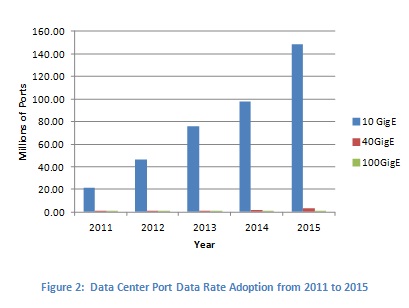By Lisa Huff, Discerning Analytics
For many years now, fiber proponents have been adamant that “copper is dead” and indeed, we’ve pretty much seen this take hold in the public network for all but the last mile. Most of the world’s carriers have realized that in order to meet their customer’s insatiable demand for bandwidth, they have to use fiber. But what about the local area network (LAN) and the data center? Well, things are starting to change there as well. Starting with Gigabit Ethernet, fiber has made inroads into what has for almost 30 years been dominated by copper. And with 10G Ethernet now being adopted quicker than ever before, fiber is becoming an even larger part of the data center network.
In fact, by 2015, DataCenterStocks.com believes that revenue from fiber-optic products will overtake copper ones in the data center as shown in Figure 1 below.
In addition to more 10G Ethernet, 40G and 100G are expected to start to be adopted as server virtualization and consolidation becomes the norm in every size data center. With many virtual servers on one physical box, the need to quickly access them through the network will drive data rates up and latency down. Figure 2 shows the expected adoption rate of 10G, 40G and 100G in the data center over the next five years.

Over the last five years, 10G ports that have been deployed in the data center (or anywhere for that matter) have been primarily fiber mainly due to the fact that they are still principally aggregation/distribution layer connections (or uplinks). Now that 10GBASE-T ports are readily available on access layer switches, some of these ports may become copper, but what is more likely to happen is that the uplinks will remain fiber and the downlinks (access layer switch to server) will change from Gigabit Ethernet to 10-Gigabit Ethernet copper – either 10GBASE-T (twisted pair) or 10GBASE-CR (twinax). This is what will fuel the higher-data rate growth shown above.
These and many more topics will be discussed in the upcoming session “Lighting Up the Data Center” at the 2012 OFC/NFOEC Conference in March.
Posted: 24 January 2012 by
Lisa Huff, Discerning Analytics
| with 0 comments